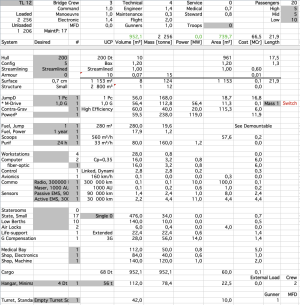AnotherDilbert
SOC-14 1K
It's just a simplification, a shortcut, to make ship design easier.Mass doesn't play into it. This is explained in game version rules that state the M-drive is gravitic in nature. A dTon of lead falls into a gravity well at the same acceleration as a dTon of feathers.
For those rule sets where the M-drive is based on something that operates using the 3rd law of motion, like a rocket, mass must be considered when calculating acceleration available from any given M-drive.
The most detailed system, TNE FF&S, described it thus:
TNE FF&S, p73:
Each cubic meter of installed thruster plate drive generates 40 metric tonnes of thrust, masses 2 tonnes, requires 1 MW of power, and cost MCr1.
Yes, a freighter will have higher acceleration when unloaded, but generally not all that much. Probably 1.something, instead of 1.0 loaded.
This contrived TNE Free Trader with almost 70 Dt cargo:

Thrust: 56.4 × 40 = 2256 t.
Mass: 2256 t / 1206 t.
So, acceleration = 2256 / 2256 = 1 G loaded, and acceleration = 2256 / 1206 = 1.87 G empty.
I have tried making a completely mass-based system, based on MT, but the end results are too similar to MT to bother with.
